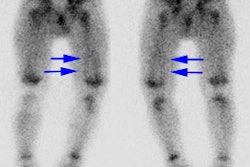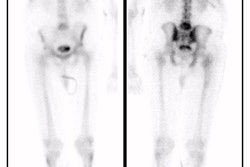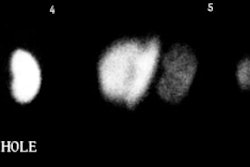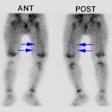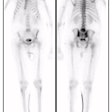Radionuclide Cystography/Vesicoureteral Reflux
Clinical Findings
The clinical manifestations of urinary tract infection in the pediatric patient population are frequently nonspecific. Children may present with fever, irritability, poor feeding, failure to thrive, or diarrhea. Older children are usually able to report the more typical complaints of urgency, frequency, and dysuria. The majority of children with a UTI have no anatomic or functional abnormality in their urinary system. UTI, however, can be associated with such a problem- most commonly vesicoureteral reflux. Because of this, all children with a well documented UTI should have further evaluation of their urinary tract.
Although vesicoureteral reflux is found in less than 1% of the general population, it is seen in about 35% of children with urinary tract infections. Vesicoureteral reflux is caused by a failure of competency of the valvular function of the normal ureterovesical junction. The normal ureter passes obliquely through the bladder wall and submucosa to its opening at the trigone. The length of the intramural tunnel, especially its submucosal component, with respect to the diameter of the ureter plays a primary role in the competence of the vesicoureteral junction. As the bladder fills with urine, the junction closes by compression like a flap-valve, thus preventing reflux. If the intramural length of the ureter is too short in comparison to its diameter, the valve will not close completely.
Fortunately, as a child grows, the ureter grows more in length than in diameter. Reflux will cease when the ratio of the length to diameter permits the valve to close. Of note, it has been shown that reflux is less likely to resolve spontaneously when ureteral dilatation is present. Reflux will resolve spontaneously in about 85% of patients with normal caliber ureters (typically 1 to 3 years), but in only about 40% of those with dilated ureters.
Reflux can be seen in up to 33 to 45% of asymptomatic siblings, and evaluation of the other children in the family is essential. It should also be noted that reflux and obstruction (UPJ) may coexist and delayed clearance of tracer from the collecting system on a retrograde study warrants further investigation.
Surgical correction of reflux should be considered for children over 11 years of age in whom reflux persists, or when infection cannot be controlled with continuous antibiotic prophylaxis.
Reflux can result in 2 forms of renal damage:
Reflux atrophy: Large volume, high pressure reflux alone causes varying degrees of pelvocalyceal system dilatation and global renal wasting. [1] Dr. Majd [Childrens Hospital, Washington, D.C.] feels that reflux without infection probably does not cause significant renal damage.
Infection: Intra-renal reflux can occur due to compound papilla which have round (rather than slit-like) orifices, and thus offer less protection against reflux. This tends to be seen more commonly at the poles. Renal parenchymal infection with resultant scarring can result from this type of reflux.
Grades of Reflux: (Radiologic VCUG)
- Grade I
Reflux is confined to the distal ureter- Grade II
Reflux to the level of the intrarenal collecting system without dilatation- Grade III
+ mild calyceal/pelvic dilatation- Grade IV
+ calyceal clubbing- Grade V
+ dilated and tortuous ureter
Grades I-III: Typically resolve as the child grows
Grades IV-V: Typically require surgery to correct
Scintigraphy
Radionuclide cystography permits visualization of very small volumes of reflux, as little as 0.2 ml at a distance of 2 cm from the bladder. It is at least as sensitive, and probably more sensitive than contrast cystography [2]. Despite the fact that minimal reflux in the distal ureter may be missed, the continuous monitoring and the irrelevancy of overlying bowel contents make nuclear cystography very effective for the detection of reflux. Bladder volume at the time of reflux appears to have prognostic significance- if the volume at which reflux occurs increases on annual examination, it may indicate a better likelihood for spontaneous cessation of reflux.
The major disadvantages of radionuclide cystography are:
- Its unsuitability for evaluation of the male urethra
- Minor bladder wall abnormalities such as small diverticula cannot be detected (although these may not be clinically significant)
- Reflux cannot be graded based upon the 5 grade international system (merely as mild, moderate, or severe, which is very subjective).
Cystitis occurring as a result of the procedure is seen only rarely (0.2% of cases).
Bladder filling volume is estimated using the formula:
Vol = (age in years + 2) x 30ml
Volume is typically underestimated in girls.
Procedure:
For a detailed description, see the SNM Nuclear Medicine Procedure Guidelines for Pediatric Cystography (June 1996)
Theoretically, Tc04 or Tc-DTPA could be absorbed across the bladder mucosa (especially if cystitis were present) and the subsequent renal excretion could result in the false-positive diagnosis of reflux. As a result, some investigators recommendusing Tc-SC. In either case, 0.5 to 1 mCi (18.5 to 37 MBq) of tracer is instilled into the bladder with normal saline. The saline bag is placed 1 meter above the table. After adequate filling, oblique projections may be obtained to help detect small amountsof reflux in the distal segment of the ureters. Refilling and revoiding techniques may detect more cases of reflux than the single fill/void technique (particularly low grade reflux). The total dose to the patient depends on the dose used, filling rate, and total filling time (usually about 1 mrad/min. to the bladder wall). Typical ovarian doses are about 5 mrad and testicular doses are about 1 to 2 mrad. For conventional contrast cystography,the dose to the bladder, gonads, and pelvic marrow is at least 75 to 100 mrad. Thus, on the average, the gonadal dose from radionuclide cystography is about one one-hundredth that of standard x-ray studies.
The clinical indications for radionuclide cystography include:
- Follow-up exam for patients with known reflux.
- Initial screening test for reflux in girls with UTI's.
- Screening of asymptomatic siblings.
- Serial evaluation of children with neuropathic bladders who are at increased risk for reflux to develop.
- Assess of the results of antireflux surgery
REFERENCES:
(1) Nuclear Medicine Annual 92, p.184
(2) Semin Nucl Med 1993; Eggli DF, Tulchinski M. Scintigraphic evaluation of pediatric
urinary tract infection. 23(3):199-218. Review.
